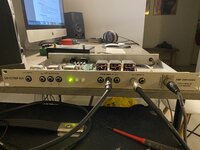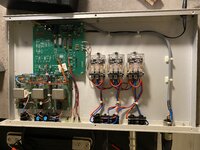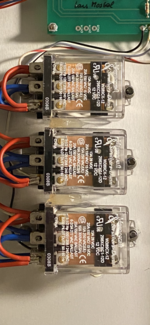*Edit* I should add that all of this applies to tube amps and the switcher should be made to handle tube amps. It would be the same concept for solid state amps, but the functionality would be different since SS doesn't need to see a load. Best to find out if this switch was made to work with solid state amps, tube amps, or both.
If it's a switcher there should be at least something acting as a load for the unused amp. Considering that it has 3 jacks labeled from amp out I would suspect this is the case.
If it was a glorified A/B/Y box everything would have gotten fried as soon as you plugged in a second amp.
In general way these things work is the they rout the signal from the selected amp to the selected speaker cabinet. That's the from amp out and to cabinet jacks respectively. Signals coming from the unselected amps are put on what is basically a dummy load of some form so that the amp will see a load and not fry itself. This should be how yours works, but I don't know the specifics of how this is achieved on your.
I see yours has 3 from amp input jack and another main input. A setup like this usually allows you to only need to plug your guitar into one place and play all amps connected, instead of having to move the cable around when switching amps. Usually the to amp input is muted for the unselected amps so there no signal bleed or risk of signal from an unselected amp overloading the dummy loads. Most likely yours will mute the signal from the unused amps, but again, not knowing the specifics I can't be certain.
In other switchers, having more than 1 speaker outputs would mean you could connect and select from several cabinets. But there would also be a selector switch for that too. I suspect the two speaker outputs on yours are parallel outputs for running 2 cabs at the same time when desired.
As far as matching impedance of amp and speaker are concerned, looks like you'll have to do that manually; unless there is a built in impedance selector which I do not see. I haven't seen any switchers with a built in impedance selector like that. This means you'll have to treat the selected amp and speaker cab as if they were directly connected and match them appropriately. For the unselected amps you don't need to worry about impedance while they're not active. The dummy load works for whichever impedance your amp is set. But overall all amps connected should have the same impedance as the speaker cab so there are no worries about a mismatch (unless you are purposely mismatching).



